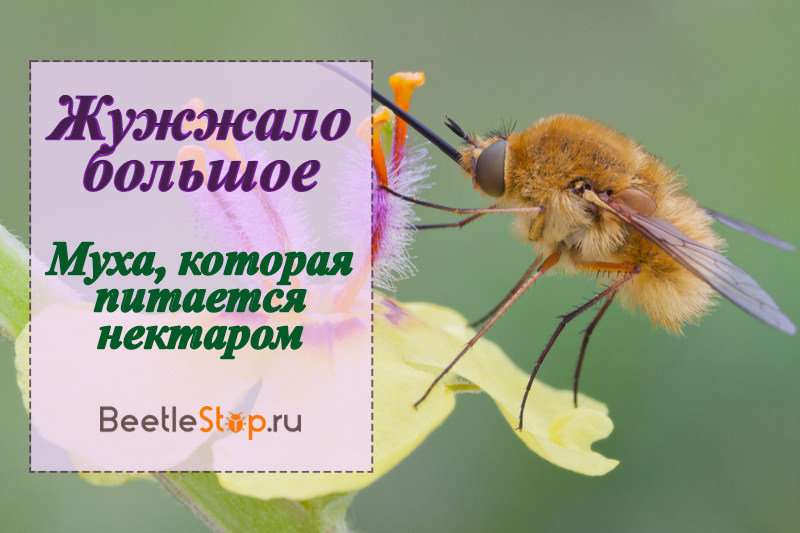Buzzing big - two-winged copy of a bee
The buzzing big one can be mistaken for a bee or a bumblebee at first sight. The shaggy body of the insect is brownish with black spots and is flying over the flowers. We are not used to seeing flies feeding on nectar, and members of the buzzing family cannot imagine life without sweet pollen. They fly from plant to plant and hover over flowers. This peculiar way of feeding flies was borrowed from moths of hawks or hummingbirds.
View description
The large buzzing bird (Bombyliusmajor) belongs to the Diptera squadron, the buzzing family (Bombayliidae). The body length of the flies is 12-18 mm, the wingspan is 24-25 mm. The body is spherical, the abdomen is short, the head is pressed to the body. The body is densely covered with brown hairs. The proboscis is long, black, non-retractable. Rigid organ adapted to suck out nectar. Its considerable length allows you to get food from deep corollas, which are inaccessible to other insects.

The eyes are large, facet, occupy most of the lateral surface of the head. Antennae short and sharp. The wings are attached to the mesothorax. The buzzing was large - the only species with a dark front edge of the wings. The limbs are long, jointed, walking. On thin shins there are spines. During the rest, Bombyliusmajor does not fold its wings over the abdomen like other flies, but places them apart.
Interesting fact. The family and appearance were called "buzzing" because of the loud sounds made during the flight over the flowers.
Distribution area
In the world there are more than 5 thousand species of the Bombayliidae family. A large buzzing fly is found throughout Europe, in parts of Asia and North America. Insects inhabit areas with a dry subtropical climate.
Lifestyle
Flies live in forest glades, in fields, on roadsides, fly into gardens. They prefer dry sunny areas. Males buzz often sitting on stones or ground, basking in the sun. This species is called spring. Adults appear after warm weather sets in April-May. Insect flights require a lot of energy, so it constantly has to be replenished. Flies flutter for several hours above the flowers, collecting pollen. Among their favorite plants:
- primrose;
- hyacinth;
- Lungworm4
- Muscari.
In the process of feeding, a large buzzing does not sit on a flower, but hangs above it, intensively flapping its wings. For convenience, the flies hold the bud with their front paws. Insects are very shy, any flickering shadow makes them fly away from places of rest.
The lifespan of adult flies is only a few weeks, by the end of May they complete the laying of eggs and die.
Breeding
Dipterans - insects with complete transformation (egg, larva, pupa, imago). For mating flies choose a place near flowering plants or near the burrows of future owners of larvae. The female lays eggs near the egg capsules (earthen cocoons) of various species of locusts and filly, in the burrows of single earthen wasps and bees. For masonry, some flies sit near the hole, placing eggs in the ground, others fling eggs with clicks of the abdomen, hovering above the entrance to the host's hole. For the exact hit of flies called "bombers."
Despite the fact that Bombyliusmajor parasitize on the larvae of various insects, they give preference to single bees andrens.The Andrena species is found everywhere, burrows in sandy soil. Buzzing outwardly resembles bees, this allows females to easily approach their burrows. The eggs of the flies are small, easily mixed with grains of sand and become invisible.
Larvae appear in a few days. They are mobile and active, immediately begin to search for the owner. Nearby locust larvae or bees become shelter and food. The development of larvae is characterized by hypermetamorphosis. This means that at different stages of development, they sharply differ in appearance and behavior. Larvae of the first age find the host's body, but do not feed. After molting, nutrition begins. Wintering takes place in the larval stage. In spring, she pupates in the host's burrow.
Value for man
Representatives of the species Bombyliusmajor are excellent pollinators of flowers. They spend a lot of time collecting nectar, so they manage to visit many plants. In regions with an arid climate, buzzing is one of the main carriers of pollen. Adult flies are beneficial, but it is incomparable with the significance of their offspring. Larvae are locust parasites. They limit the number of hazardous agricultural pests.
The decrease in the number of husband buzzing is associated with a reduction in the colonies of bees that are the owners of the larvae. Human activities, steppe fires and the use of pesticides are also negative factors.


 (votes: 9, average rating: 4,89 out of 5)
(votes: 9, average rating: 4,89 out of 5)